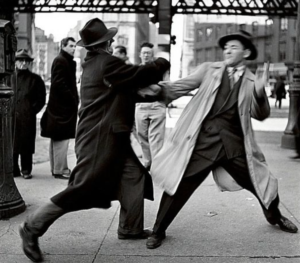In the pantheon of great photographers, Elliot Erwitt stands out as a master of the everyday. With a career spanning over seven decades, Erwitt has captured the essence of human experience, revealing the beauty and humor in the mundane.
Born in 1928, Erwitt’s fascination with photography began at a young age. Growing up in Milan, Italy, he was surrounded by the city’s vibrant street life, which would later become a hallmark of his work. After immigrating to the United States, Erwitt began his photographic journey, studying at the New School for Social Research in New York City.
Erwitt’s early work was marked by a sense of curiosity and wonder. He roamed the streets, camera in hand, capturing the intricacies of urban life. His photographs from this period, often shot in black and white, possess a timeless quality, as if frozen in a bygone era.
In the 1950s, Erwitt’s work caught the attention of Roy Stryker, the legendary director of the Farm Security Administration’s photography project. Stryker saw something special in Erwitt’s images – a unique ability to distill the essence of a moment, often with a hint of humor.

This led to Erwitt’s involvement with Magnum Photos, the prestigious photography cooperative founded by Henri Cartier-Bresson, Robert Capa, and others. As a member of Magnum, Erwitt traveled the world, documenting the human condition in all its complexity.
From the streets of New York City to the beaches of France, Erwitt’s photographs reveal a deep understanding of human nature. He has an uncanny ability to capture the decisive moment, often with a sense of wit and irony.
One of Erwitt’s most famous images, “New York City, 1950,” showcases his skill. In the photograph, a group of people stand on a street corner, each lost in their own world. A woman gazes up at a billboard, while a man looks down, reading a newspaper. A young boy, seemingly oblivious to the commotion, walks towards the camera, his eyes fixed on something in the distance.
The image is a masterclass in observation, a snapshot of urban life that reveals the beauty in the everyday. It’s a testament to Erwitt’s ability to find meaning in the mundane, to uncover the hidden narratives that surround us.
Throughout his career, Erwitt has been drawn to the absurdity and humor in life. His photographs often feature animals, particularly dogs, which he sees as a reflection of human nature.
In “California, 1955,” a photograph shot for Life magazine, Erwitt captures a group of dogs sitting in a car, each wearing a pair of sunglasses. The image is a hilarious commentary on the human desire to anthropomorphize animals, to see ourselves in them.
Erwitt’s work has also explored the world of politics and celebrity. He has photographed countless icons, from Marilyn Monroe to Nikita Khrushchev, each image revealing a unique aspect of their personality.
In “Moscow, 1958,” Erwitt captures a rare moment of levity from Khrushchev, the Soviet leader, as he shares a laugh with a group of officials. The image humanizes a figure often seen as austere and unyielding.
As Erwitt’s career has evolved, so too has his approach to photography. He has embraced color, experimenting with new techniques and technologies. His later work, often shot in digital, possesses a vibrancy and immediacy, as if the images are unfolding before our eyes.
Despite the many changes in his life and work, Erwitt remains committed to his art. He continues to roam the streets, camera in hand, observing and documenting the world around him.
In an era where photography has become ubiquitous, Erwitt’s work stands out as a testament to the power of observation and wonder. His images remind us that beauty and humor can be found in the most mundane moments, that the everyday is, in fact, extraordinary.
As we look back on Erwitt’s remarkable career, we are reminded of the importance of slowing down, of observing the world around us. In a world that increasingly values speed and efficiency, Erwitt’s photography encourages us to pause, to reflect on the beauty in the everyday.
In the end, Erwitt’s work is a celebration of life, in all its complexity and humor. His photographs are a reminder that, no matter where we are or what we do, we are all connected, united in our shared human experience.
